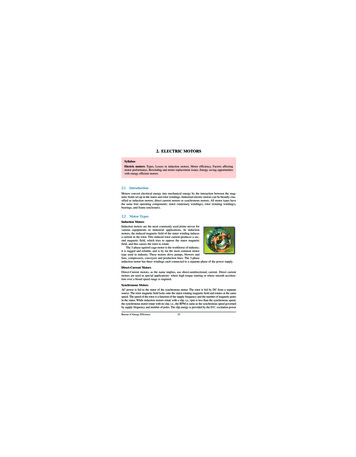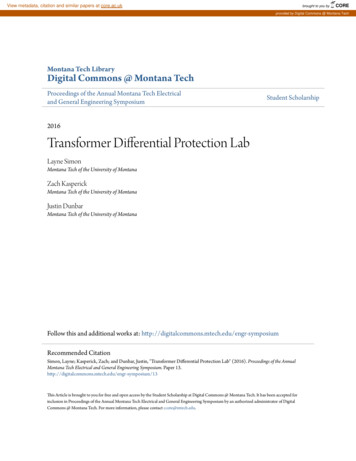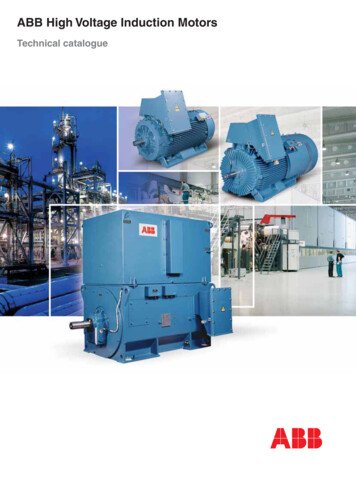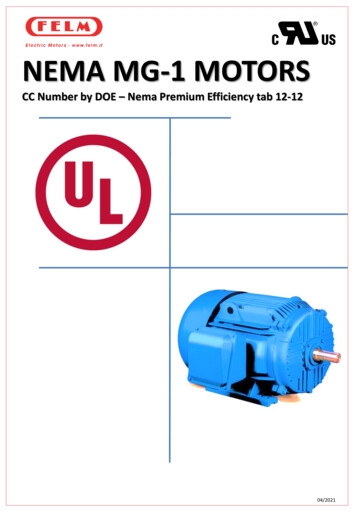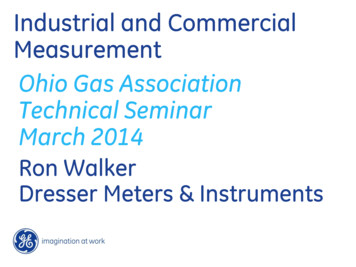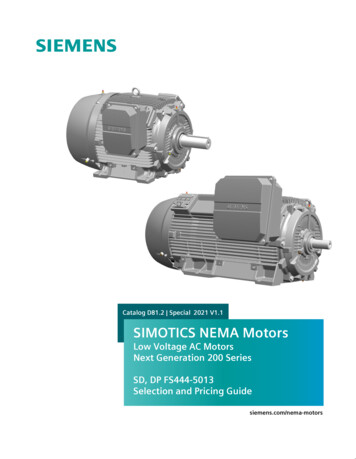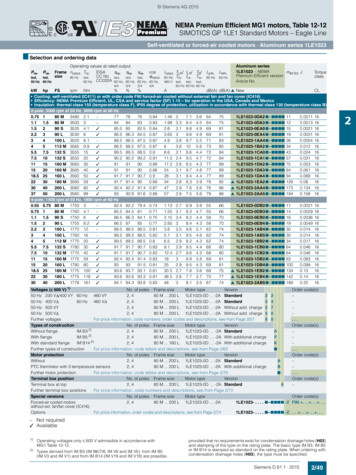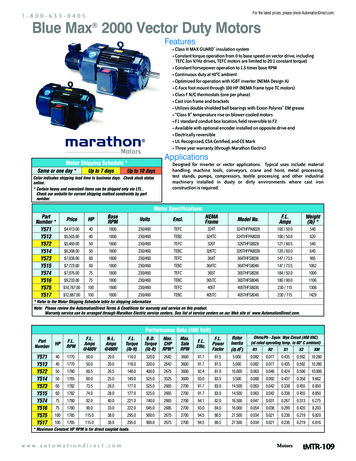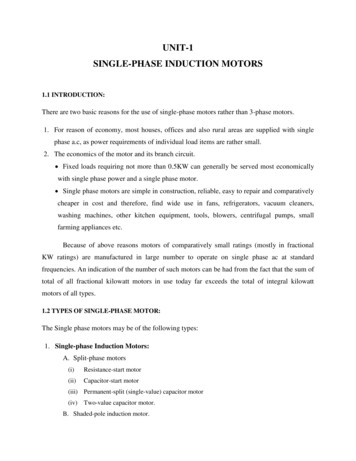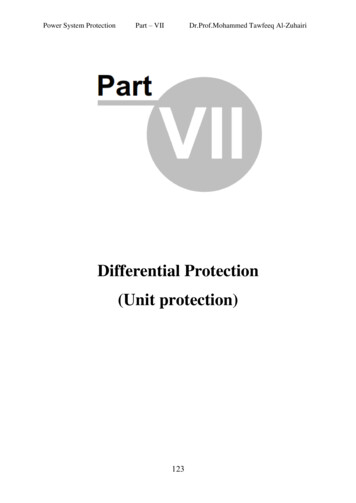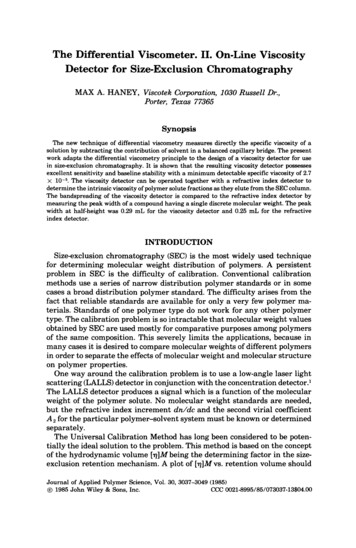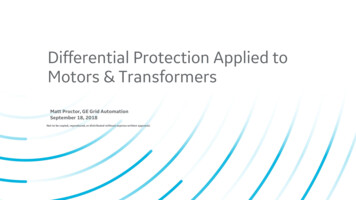
Transcription
Differential Protection Applied toMotors & TransformersMatt Proctor, GE Grid AutomationSeptember 18, 2018Not to be copied, reproduced, or distributed without express written approval.
The Art & Science of Protective RelayingC. Russell MasonWiley; 1 edition (January 15, /artsci.pdfCAUTION CONCERNING APPLICATION-RELATED STATEMENTS:This document contains a technical review of protective relaying techniques and practices. Protective relaying is both an art and a science. Any recommendations made in this presentation canbe assumed to be general and subject to change based on application-specific details. If you misinterpret a recommendation in this presentation and cause a nuisance trip or failure to trip,please do not blame this presentation, the presenter or the presenter’s affiliated company. Thank you.
Characteristics of Good Protective RelayingThe “5 S’s” Mnemonic SpeedWhen it needs to operate, you want it to operate fast. SelectivityIdeally, you only de-energize the faulted equipment and nothing more. SensitivityThe best protection system can detect any fault, large or small. SecurityA good protection system trips when you need it to and never trips otherwise. SimplicityIdeally, no engineering effort is required, and it’s very inexpensive.Presentation Title3
Basics of Differential Relaying4
Basic Differential PrincipleKirchoff’s Current Law: Current in should equal current out. Otherwise, there’s a fault.2 pu1 puIPCT-XIPCT-Y2 puFaultIPCT-XIPCT-YXISISISISRelayRelayIR-XIR-XIR-Y 2Idiff 1 (-1) 00Current, pu 1Current, puIR-YIdiff 2 ( 2) 40-2-1timetime5
Basic Electromechanical Differential PrincipleRelays use restraint to increase security.87B 4CDifferential CurrentOperateCoilRestraint CoilZone of Protectionthrough-currentTRIP0CBA-4ACT errorRestraint Current6
Electromechanical PrincipleANSI Function 60 – Voltage or Current Balance RelayANSI Function 87 – Differential Protective RelayI12 I21Differential CurrentI1I2Digital Representation ofElectromechanical PrincipleTRIPBCARestraint Current“Operate” current creates a tripping force.“Restraint” current creates a counter-tripping force.7
Differential Relaying Applied to Motors8
Why Use Stator Differential?Limit Damage to Windings. Save the Core. Text Level 1Stator CoreText Level 2Stator Windings Text Level 3Text Level 4Single lamination9
Why Use Stator Differential? SpeedLimit the destructive energy in a faultby clearing it quickly. No delayrequired. SensitivityDetect a fault at its incipience beforeit evolves into a lower impedance(higher current) fault.10
Why Use Stator Differential? IEEE 1068 – IEEE Standard for the Repair and Rewinding of ACElectric Motors in Petroleum, Chemical and Process Industries.If the core damage is less than 10% of surface area, the core might be repairedby air hammer and/or grinding.Beyond 10% surface area damage of if a hot-spot can’t be fixed byaforementioned methods, you may be re-stacking the core.11
Is Stator Differential Recommended?If you have a fused contactor, the answer is most likely, “No.”If the interrupting device includesfuses, let those fuses do their job.Otherwise, risk damaging acontactor.Don’t assume a fault will beincipient (high impedance/lowcurrent)12
Is Stator Differential Recommended?If you have a breaker, the answer is, “Maybe.” IEEE C37.96 – IEEE Guide for AC Motor ProtectionRule of thumb: If the motor kVA rating is less than half the transformer,use overcurrent (50) in lieu of differential (87). IEEE Standard 242 – Buff Book All motors 750 kVA and above on ungrounded systems.All motors 750 kVA and above on grounded systems where groundfault protection won’t detect phase-phase faults.Smaller MV motors (although 1900 kVA is easy to justify).13
How is Stator Differential Implemented?“Core Balance” or “Flux-balance” method Preferred methodMost secure because flux inherentlycancels for non-fault conditions.87MMotor/ StatorDifferentialAlmost any protection class CT can beused. Digital relays are very good atresponding within spec (fast) for anIOC (or DIFF) element despite severesaturation. Unbelievably enough,60kA through a 100/5 C10 CT wouldprobably still work for an 87M. Checkwith your relay manufacturer.Be aware of proximity effects.Currents can be induced on thesecondary circuit and cause nuisancetrips if the pickup is too sensitive.14
How is Stator Differential Implemented?“External Summation” method Not Optimalpickup setpointPoor (and unequal) CT performance because of asymmetrycauses false differential currents on startup.Can be addressed by adding a start delay to the protectivefunction, or gradually increasing sensitivity as motor starts, butthis is not ideal.motor startmotor fullyacceleratedtime15
How is Stator Differential Implemented?“External Summation” methodNotice the asymmetricalnature of this inductionmotor start. CT’s performpoorly underasymmetrical currents.16
How is Stator Differential Implemented?“Internal Summation” method Preferred method if corebalance is not practical.-Percent Slope Differential can be applied.Addresses CT inaccuracy issues withoutintroducing time delay or decreasingsensitivity.Addresses CT inaccuracy for both motorstarting and fault-circuit contribution.Differential Current-TRIPBCARestraint CurrentNote the CT polarity. This can vary by manufacturer.17
Differential Relaying Applied toTransformers18
Transformer Protection BasicsArt & Science Confirmed by IEEE Standard. “There is no one standard way to protect all transformers, oreven identical transformers that are applied differently.”- IEEE C37.91 Protection of Power TransformersConsider these factors when developing a protection scheme:oRepair damageoCost of lost productionoAdverse effects on the rest of the systemoCollateral damage to other equipmentoTime that damaged equipment will be out of service.19
Is Transformer Differential Recommended?It depends. See list of factors to consider on previous slide.For transformers 2500KVA and below,medium and low voltage windingsFor transformers 750KVA andabove, medium voltage windingsSource: GE Relay SelectionGuide, GET-8048A circa2002I disagree with thisrecommendation on groundsthat arc-flash incident energycould be greatly reduced with87T.20
Challenges of Transformer DifferentialIt’s usually not as simple as stator differential. CT mismatch Transformer winding phase shift Zero-sequence current compensation Ground fault sensitivity in impedance grounded systems Magnetizing current inrush CT performance21
Challenges of Transformer DifferentialCT mismatch.H2/IBH3/ICH1/IAIn the days before digital relays, CT ratios would need tobe sized to “normalize” secondary currents as closely aspossible.In this example 2MVA Dy30 transformer, CT ratios of100/5 and 3000/5 might be chosen to “normalize” thefull load secondary amps at approx. 4.2 MVA/13.8kV(SQRT(3) 83.6 Pri 4.18 secondary.2 MVA/0.48kV(SQRT(3) 2405 Pri 4.00 secondary.100/5100/5100/513.8 kV0.48 kV2 MVAR3000/5In other words, a digital relay would scale the 4secondary amps of measured current at 480V by 1.04 tomake it equal the 4.18 amps measured at 13.8kV.3000/53000/5X3/IcX2/IbIn digital relays, the currents are mathematicallynormalized to a reference winding. If the 13.8kVwinding is used as the reference, a relay would scale the480V winding currents using this factor:(3000/5) x 480V / (100/5)/13800 V 1.04.X1/Ia22
Challenges of Transformer DifferentialTransformer Winding Phase Shift.H2/IBH3/ICH1/IATransformer nameplates will identify the phase shift.MOST of the time, we deal with standard ANSItransformers whose secondary windings lag the primaryby 30 degrees.IC IC’-IB’100/5IB IB’-IA’100/5IA IA’-IC’100/513.8 kV0.48 kV2 MVAIC’*N Ic’ IcIB’*N Ib’ IbIA’*N Ia’ IaI C’IB’IA’I c’Ib’Ia’Electromechanical relays accounted for that phase shiftwith CT wiring. Notice the delta-wired CT’s on thesecondary winding in this example.Ignore the turns ratio and the CT ratios, and it is easy tosee how these current summations elegantly sum tozero for normal load or through-faults.RIa Ia’-Ic’3000/5Ib Ib’-Ia’3000/5Ic Ic’-Ib’3000/5X3/IcX2/IbX1/Ia23
Challenges of Transformer DifferentialTransformer Winding Phase Shift.This is an example of the phasors that one would expectto see for a Dy30 transformer with ABC rotation.Notice Ia, when flipped 180 degrees to account for CTpolarity (both winding CT polarities are AWAY from thetransformer), it lags IA by 30 degrees.IaIA30 lag-ICIt’s important to understand that a microprocessorrelay is not just “shifting” phasors to account for. phase angle shift. It is applying the same complexalgebra that an electromechanical systemaccomplished with physical summation byconnecting wiresIA-IC Ia24
Challenges of Transformer DifferentialTransformer Winding Phase Shift - Example.The relay expectsABC.IC.IA30 lead 330 lagIA-IC IaICThis Dy30 transformer’s relay hasbeen programmed to expect ABCrotation, but it has been wired asACB.The dashed line shows thecalculated angle-compensatedvalue of Ia. It should be 180degrees out-of-phase with themeasured Ia on the right.IB25
Challenges of Transformer DifferentialTransformer Winding Phase Shift - Example.Even though the phase rotation is ACB, we can see thatthe secondary currents are still lagging primary by 30deg.Ic lags IC by 30 deg.If we misunderstandwhat the relay is doingand assume that therelay simply shifts Ia, Ib &Ic forward by 30 degrees,it’s hard to understandwhy this does not work.-Ia lags IA by 30 deg.-Ib lags IB by 30 deg.26
Challenges of Transformer DifferentialTransformer Winding Phase Shift - Example.Notice the in-phase relationshipbetween calculated Ia and measured Ic,between calculated Ib and measured Ia, andbetween calculated Ic and measured Ib.IC-IB IcIC-IBFor example, the mathematicaloutcome of Ia would sum to zero if itwere summed with measured Ic.-IAIf we know the math that the relay isapplying for phase angle compensationfor a Dy30 with ABC, we can see thatthe secondary phases are all wired intothe wrong spot. They have all beenrolled.-(IA-IC)-(IB-IA)IB-IA IbIa-(IC-IB)IA30 lead 330 lag-ICIA-IC IaIBSecondary phases appear to be rolled.Measured Ia is actually Ib.Measured Ib is actually Ic.Measured Ic is actually Ia.27
Challenges of Transformer DifferentialZero-Sequence Current Compensation.When 1LG faults occur outside the zone of protection on thewye side, the differential must not operate.100/5A review of the current flow in the relay’s CT circuits shows howthe delta-wired CT’s in an electromechanical system negate thecurrents that flow in two phases on the delta side.100/5100/513.8 kV0.48 kV2 MVARDigital relays perform this zero-sequence current compensationmathematically, using the aforementioned equations used inphase angle compensation, so there is no need for delta-wiredCT’s.3000/53000/53000/528
Challenges of Transformer DifferentialGround fault sensitivity in impedance grounded systemsRelay compares measured Ig to calculated 3I0. This is one reason that delta-connected CT’s are not recommended.Delta-connected CT’s negate the relay’s ability to calculate 3I0.29
Challenges of Transformer DifferentialMagnetizing Current Inrush When a transformer is energized, inrush current can be as high as 10 x FLC ofthe transformer. Inrush lasts for only a few cycles but can cause the differential element tooperate because it has the appearance of an internal fault (current flows intobut not out of the unloaded transformer). Predominantly 2nd harmonic. Digital relay filters can eliminate the 2nd harmonic component from “restraintcoil” currents to restrain operation during inrush.30
Challenges of Transformer DifferentialMagnetizing Current Inrush All transformers must establish flux in the transformer coreThis flux causes a current to flow known as the magnetizingcurrentMagnetizing current appears as differential current31
Challenges of Transformer DifferentialMagnetizing Current InrushMagnetic Hysteresis LoopNon-Linearity of the core results in a non-linear magnetizingcurrent waveform Notice flux lags excitation voltage by 90 degrees Steady State Magnetizing current is in the range of1-3% of XFMR Full Load Amps 32
Challenges of Transformer DifferentialMagnetizing Current Inrush When an abrupt change in excitation voltage occurs, as whentransformer is en energized, a large magnetizing current can flow.Magnetic hysteresis loop becomes negligible.The Magnetizing Inrush Current is dependent on several factors, whichwill be discussed on the following slides33
Challenges of Transformer DifferentialMagnetizing Current InrushFlux above saturation knee point34
Challenges of Transformer DifferentialMagnetizing Current Inrush – Point on Wave Switching ee TimeStart of event TimeStart of eventHighest magnitude inrush occurs when excitation voltage is applied atzero crossingLowest magnitude inrush occurs when excitation voltage is applied at–90 degreesSwitching point is not controlled thus magnitude of inrushunpredictable35
Challenges of Transformer DifferentialMagnetizing Current Inrush – Remanent Flux Remanent Flux can be 30-80% of maximum core flux Remanent Flux can be positive or negative This can lead to increased or decreased magnetizing inrush current Amount of remanent flux present is unpredictable36
Challenges of Transformer DifferentialMagnetizing Current Inrush – Core Design Saturation flux density and peak flux density of atransformer core is primarily affected by core design Steel quality has remained constant over the years Laminated core designs have become more common Laminations provide an air gap between eachlamination – resulting in lower steady state and inrushmagnetization currents37
Challenges of Transformer DifferentialMagnetizing Current Inrush – Core Design Laminated core designs lead to lowerreluctance cores Lower reluctance cores are more efficientleading to lower magnetizing current38
Challenges of Transformer DifferentialMagnetizing Current Inrush – Impact of Power System The peak magnitude of the inrush current is dictated by thestrength of the power system source The duration of an inrush event is dictated by the resistivelosses in the circuit The change in flux over time is defined by:39
Challenges of Transformer DifferentialMagnetizing Current Inrush – Naturally non-linearNot Symmetricabout Y-AxisIDEAL INRUSH WAVEFORM40
Challenges of Transformer DifferentialMagnetizing Current Inrush – Rich in even harmonicsDominated by2nd HarmonicIDEAL INRUSH WAVEFORM41
Challenges of Transformer DifferentialMagnetizing Current Inrush – Causes CT saturationDistortion from CTSaturation15MVA – 66kV to 6.9kV Transformer42
Challenges of Transformer DifferentialMagnetizing Current Inrush – Causes CT saturationDominated by2nd Harmonic15MVA – 66kV to 6.9kV Transformer43
Challenges of Transformer DifferentialMagnetizing Current Inrush – When does it occur? During Transformer Energization: Typically the most severe case, because excitationvoltage is going from zero to maximum valueFor three phase transformers, each phase willexperience different peak values of inrush current due tothe voltage angle at the time of switching44
Challenges of Transformer DifferentialMagnetizing Current Inrush – When does it occur? During Post Fault Voltage Recovery: During a fault, the system voltage is depressed and thenreturns to full valueThis change in voltage can lead to inrush currentssimilar to energization of transformerNot typically as severe as Energization because Fluxwon’t be fully offset from excitation voltageThe presence of load current will act to lower ratio ofsecond harmonic to fundamental current45
Challenges of Transformer DifferentialMagnetizing Current Inrush – When does it occur? Sympathetic Inrush: When two or more transformer banks in parallel are energizedsequentiallyEnergization of the first transformer will cause magnetizing inrushcurrent to flow with no additional effectsEnergization of second transformer can cause significant voltagedropVoltage drop effects previously energized transformer, causing it todraw inrush current in opposite direction46
Challenges of Transformer DifferentialMagnetizing Current Inrush – When does it occur? As shown earlier, high levels of inrush current cancause differential relay misoperationWe need to identify this condition and stop thedifferential relay from operating while inrushcondition is presentMany methods exist, all rely on the characteristicsof the inrush waveform47
Challenges of Transformer DifferentialMagnetizing Current Inrush – Percentage of Total Harmonic Method This method utilizes the fact the inrushwaveform is rich in harmonicsTypically applied in EM relays per phaseProblems More efficient core designs produce less harmoniccontentCT Saturation essentially creates a setting “floor”48
Challenges of Transformer DifferentialMagnetizing Current Inrush – Percentage of Total Harmonic Method Typical values of 2ndharmonic tofundamental ratios arein the range of10%-60%Can be much lower asshownMicroprocessor relayshave introducedmethods to deal withthis problem49
Challenges of Transformer DifferentialMagnetizing Current Inrush –4th Harmonic Method This method utilizes the fact the inrushwaveform is not symmetric, leading to evenharmonicsUsed in some microprocessor relaysCT Saturation still a problemNo significant benefit over 2nd harmonicmethod50
Challenges of Transformer DifferentialMagnetizing Current Inrush – Wave Shape Method Relies on flat spots near zerovalue ( 1/4 cycle)CT saturation can compromisesecurity and dependabilityWere used widely in solid-staterelaysDifferential element delayed by1 full cycle51
Challenges of Transformer DifferentialMagnetizing Current Inrush – Adaptive Method Method utilizes 2nd HarmonicMagnitude and AngleDynamically restrains over amaximum of 6 cyclesMay slow operation by a fewcycles if 2nd harmonic current ispresent52
Challenges of Transformer DifferentialMagnetizing Current Inrush – Adaptive Method If the second harmonic drops magnitude-wise below 20%, thephase angle of the complex second harmonic ratio (I2/I1) isclose to either 90 or -90 degrees during inrush conditionsThe phase angle may not display the 90-degree symmetry ifthe second harmonic ratio (I2/I1) is above some 20%If the second harmonic ratio (I2/I1) falls bellow 20% makingan angle of 90 with the fundamental current, the algorithmapplies adaptive lenses, and time for which the 87T protectionis inhibitedMethod dynamically lowers the restraint threshold at thebeginning of inrush event and gradually increases back to thesetting valueCT saturation impacts speed53
Challenges of Transformer DifferentialMagnetizing Current Inrush – Adaptive Method ExampleTransformer D/Y30, 13.8/115 kVenergized from Wye side54
Challenges of Transformer DifferentialMagnetizing Current Inrush – Adaptive Method Example4. 5cyclesInrush current on transformerenergization – phase C55
Challenges of Transformer DifferentialMagnetizing Current Inrush – Adaptive Method Example2.11cyclesInrush current ontransformer energization– phase A2nd harmonic 9.9%56
Challenges of Transformer DifferentialMagnetizing Current Inrush – How should these methods be applied? Electromechanical relays typically usedeither % total harmonic or % 2ndharmonic methodsElectromechanical relays applied them ona per-phase basisMicroprocessor relays can apply manymethods on a per-phase, 1 out of 3(cross blocking), 2 out of 3, or averagebasisPros and Cons to each57
Challenges of Transformer DifferentialMagnetizing Current Inrush – How should these methods be applied? 1 out of 3 (Cross Blocking)– Very secure, butcan reduce reliability or speed: Per Phase – Less secure, very reliable: Consider fault during energizationConsider low 2nd harmonic inrushUse on three-phase bank of single phase XFMRS2 out of 3 – More secure than Per Phase,potentially less reliableAveraging Method – More secure then PerPhase or 2 out of 3, no compromise onreliability58
Challenges of Transformer DifferentialMagnetizing Current Inrush – How should these methods be applied? Security & Speed: Security (speed not important): Adaptive method and per phaseDependability & Speed: 2nd harmonic method and cross blocking oraveraging mode2nd harmonic method and per phase oraveraging modeDependability, Security & Speed: 2nd harmonic method and averaging mode59
Challenges of Transformer DifferentialCT Performance – Pickup, Slope, BreakpointPickupCT’s can be within measurement accuracyand still be /- 10%. Weight benefits vsconsequences before setting below 0.2per unit.-In MV petrochemical applications, considersetting the pickup at 2 x load. The benefit ofthis conservative approach is to prevent anuisance trip even in the case that someonewired the CT polarities backwards. Alarm onhigh diff current.60
Challenges of Transformer DifferentialCT Performance – Pickup, Slope, BreakpointSlope 1Protection Class CT’s can be withinmeasurement accuracy and still be /10%. One measuring at 10, the othermeasuring at -10% at full load results in aIdiff/Irest 20% for a two-windingtransformer. Weight benefits vs.consequences before setting lower than30%.61
Challenges of Transformer DifferentialCT Performance – Pickup, Slope, BreakpointBreakpoint 1Divide CT kneepoint voltage by CT burdenthen multiply by 20%. This methodaccounts for extremely poor CTperformance at low magnitudes due toremanence.Breakpoint 2Divde CT kneepoint voltage by CT burden.In MV petrochem applications, considersettings same or very close to Breakpoint 1.This adds security and makes testing easier.62
Challenges of Transformer DifferentialCT Performance – Pickup, Slope, BreakpointSlope 2- Slope 2 accounts for CT measurementerrors during worst-case fault condition:Maximum fault current Worst-performingCT- Slope 2 setting should be high enoughto override differential current created byworst case CT saturation condition- A worst-case scenario occurs when onlyone of the differential CTs saturatesseverely due to a through (external) faultcurrent, and other differential CTs do notsaturate63
Challenges of Transformer DifferentialCT Performance – IEEE PSRC CT Saturation ToolThe IEEE PSRC CT Saturation Tool is a great,freely downloadable spreadsheet that helpsvisualize what your actual CT performance ismost likely to resemble.Use it to set your slope 2 setting according to themaximum deviation of the Actual & Ideal RMSValues. Based on the discrepancy between Ideal CT RMS value andAcutal RMS value in this example, we can estimate Idiff/Irestr 0.63so Slope 2 could be set to 63% or higher.64
Challenges of Transformer Differential 24 Transformer Winding Phase Shift. This is an example of the phasors that one would expect to see for a Dy30 transformer with ABC rotation. Notice Ia, when flipped 180 degrees to account for CT polarity (both winding CT polarities are AWAY from the
